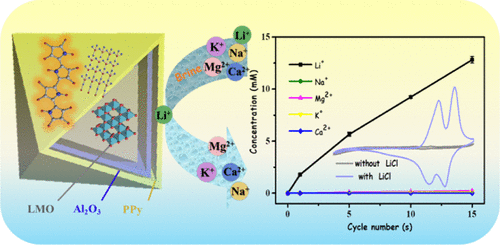新闻链接: https://www.x-mol.com/paper/1235264054758305792
Efficient Lithium Extraction from Brine Using a Three-Dimensional Nanostructured Hybrid Inorganic-Gel Framework Electrode
ACS Sustainable Chemistry & Engineering ( IF 6.970 ) Pub Date : 2020-03-19 , DOI: 10.1021/acssuschemeng.9b07644
Xiaoyu Zhao; Yaoxin Jiao; Peijie Xue; Minghui Feng; Yanfei Wang; Zuoliang Sha
 |
Electrochemical extraction of lithium from solution is an urgently needed process because of the abundant reserves of lithium in seawater/brine and many disadvantages of the present technologies including high energy consumption, low separation efficiency, and being harmful to the environment. Competitive electrode materials used in electrochemical extraction require high cyclic stability in corrosive ion-rich seawater/brine. In this work, a three-dimensional (3D) nanostructured hybrid inorganic-gel framework electrode of polypyrrole/Al2O3 was introduced on the surface of LiMn2O4 for the first time. It was paired with activated carbon to construct an asymmetric lithium capacitor with advantages of cost effectiveness, good cycle stability in brine, high selectivity, and capacity. Furthermore, a flow control system was induced to make lithium extraction a continuous operation, which will be favored by the industry. The Li+ extraction energy consumption was 1.41 W h·mol–1 Li+ with a capacity of 1.85 mmol·g–1 in simulated brine. The capacity retention after 30 cycles was 91.66% at the 1 C rate. These promising results indicate that the PPy/Al2O3-modified LMO possesses high extraction efficiency and long-term stability in complex brine medium.
